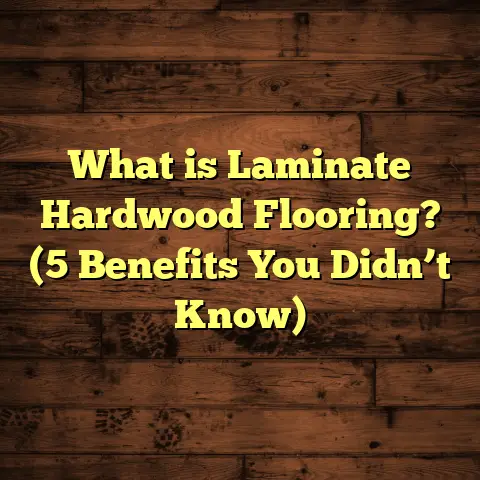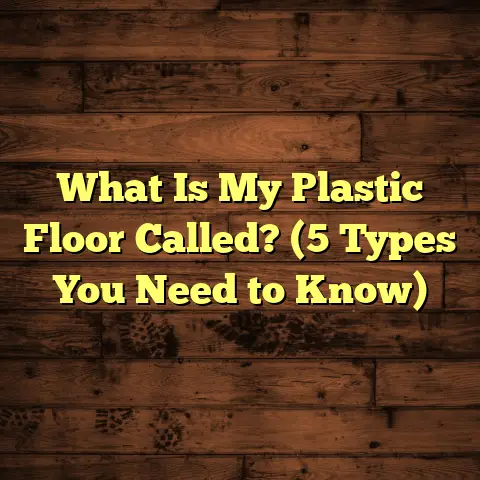What is a Floating Floor Made Of? (5 Materials You Didn’t Expect)
Endurance is one of the first things I think about when choosing flooring. If a floor can’t stand up to daily life—the kids running around, pets scratching, or even just normal wear and tear—it doesn’t matter how beautiful it looks. Over the years, floating floors have become one of my favorite options because they combine durability with ease of installation and versatility. But I often get asked, “What exactly is a floating floor made of?” It’s a good question because the answer isn’t always what people expect.
I’ve worked on dozens of projects using floating floors, and I want to share what I’ve learned about the core materials behind them. Some materials you’ve likely heard of, but others might surprise you. Plus, I’ll share real experiences, data, and insights so you can make smarter choices for your own space.
What is a Floating Floor?
So, what exactly is a floating floor? The term sounds like something that floats above the ground, right? Well, that’s not far off in concept, but not in the way you might imagine.
A floating floor is a type of floor that’s not attached permanently to the subfloor beneath it. Instead, the flooring pieces connect to each other, usually through a tongue-and-groove or click-lock mechanism, forming a unified surface that rests on top of an underlayment or padding. This “floating” aspect means the floor can expand and contract naturally without buckling or cracking.
This construction method contrasts with traditional flooring installation methods where nails or glue fix the floor to the subfloor. Floating floors give you flexibility and easier installation, which is why they’re popular for DIY projects as well as professional installs.
Why Floating Floors?
When I started using floating floors in my work, the main attraction was their endurance combined with ease of installation. They allow for:
- Movement: Wood and other materials expand and contract with temperature and humidity changes. Floating floors accommodate this movement without damage.
- Versatility: You can install floating floors over concrete, existing tile, plywood, or even old vinyl.
- Speed: Installation times are faster because there’s no need for nails or glue.
- Repair: Damaged planks can be replaced without tearing up the entire floor.
Naturally, the materials used play a massive role in these benefits. Let me walk you through five materials behind floating floors that may surprise you.
1. Wood Plastic Composite (WPC)
I first encountered Wood Plastic Composite on a waterfront renovation project where moisture resistance was non-negotiable. The homeowners wanted wood-look flooring but needed something that wouldn’t warp or swell with humidity and occasional spills.
WPC is essentially a blend of wood fibers and plastic polymers. This combination creates a material that looks and feels like wood but has enhanced resistance to water and wear.
What Makes WPC Special?
- Water Resistance: Unlike traditional hardwood or laminate, WPC floors don’t absorb water easily.
- Comfort: It has a softer underfoot feel compared to laminate thanks to its composite core.
- Variety: Comes in many realistic wood grain finishes and colors.
- Durability: Resistant to scratches and dents better than standard laminate.
My Experience with WPC
On the coastal project, WPC was installed in kitchens and bathrooms where humidity levels fluctuated constantly. The floors held up perfectly for over five years with minimal maintenance. Compared to laminate floors I’d installed earlier, which showed water damage within months, WPC was a game-changer.
Data Snapshot
Industry reports show WPC flooring demand has grown by 15% annually since 2018, largely driven by consumer desire for both aesthetic appeal and waterproof performance.
2. Stone Plastic Composite (SPC)
SPC took me by surprise when I first saw it. Unlike wood-based composites, SPC is made from limestone powder mixed with plastic stabilizers to form an incredibly dense core.
This material is prized for its hardness and waterproof qualities.
Why SPC?
- Hardness: It is significantly harder than WPC or laminate floors.
- 100% Waterproof: No swelling or warping even if submerged briefly.
- Thin Yet Strong: Offers great durability without bulk.
- Stability: Doesn’t expand or contract much with temperature changes.
Real-Life Use Case
I installed SPC flooring in a commercial office lobby that saw hundreds of visitors daily. After two years, there was minimal wear despite constant foot traffic and rolling office chairs. The material’s rigidity contributed to its longevity far beyond what laminate or engineered hardwood could have handled in that setting.
Technical Insight
SPC flooring’s density often measures around 1.9 g/cm³ compared to 0.7 g/cm³ for typical wood products. This density contributes to its impact resistance and hardness rating comparable to some hardwood species on the Janka hardness scale.
3. High-Density Fiberboard (HDF) Core Laminate Flooring
Many people think laminate flooring is just one material but don’t realize the critical role played by the core layer—usually High-Density Fiberboard.
HDF is made by compressing wood fibers together under heat with resin binders to create a dense, stable core.
Why HDF Works:
- Strength: Offers solid support to prevent denting or warping.
- Cost-Effective: More affordable than hardwood or composites.
- Design Flexibility: Topped with photographic layers that mimic wood or stone.
- Installation: Click-lock systems make it easy to install as a floating floor.
My Experience
In rental properties where budgets were tight but durability was needed, HDF-core laminate was my go-to choice. While not waterproof like WPC or SPC, it holds up well in living rooms and bedrooms if spills are cleaned promptly.
However, I avoid using HDF laminate in basements or bathrooms due to moisture sensitivity.
Industry Trends
Laminate flooring still holds about 30% market share in residential flooring due to affordability and design variety. HDF cores have improved durability compared to older MDF cores, reducing complaints about sagging or swelling.
4. Plywood Substrate with Floating Engineered Hardwood
Engineered hardwood often surprises clients because they assume all hardwood must be nailed down. But a floating system using plywood substrates beneath engineered hardwood layers is a popular method I’ve used many times.
Engineered hardwood consists of a thin veneer of real wood on top of plywood layers arranged crosswise for stability.
Why Use This Combo?
- Authentic Look: Real wood grain on top gives beautiful aesthetics.
- Stability: Plywood base reduces expansion/contraction issues.
- Floating Installation: Easier than solid hardwood nailed down directly.
- Repair-Friendly: Sections can be replaced without major demolition.
My Story
One client wanted the warmth of real wood but was concerned about installing over concrete. Using engineered hardwood over plywood floating allowed us to give them beautiful hardwood flooring without worrying about moisture problems common with nailed solid wood floors on concrete slabs.
Performance Data
Engineered hardwood with plywood substrate typically withstands humidity changes better than solid hardwood by 30%-40%, drastically reducing warping risks.
5. Cork Floating Floors
Cork caught my attention when I started working with eco-conscious clients who wanted natural materials offering comfort and sound insulation.
Made from bark harvested sustainably from cork oak trees every 9 years, cork is an interesting alternative for floating floors.
Benefits of Cork:
- Renewable Resource: Harvesting doesn’t kill the tree.
- Soft Underfoot: Offers natural cushioning ideal for standing long periods.
- Sound Absorption: Great noise dampening qualities.
- Thermal Insulation: Keeps rooms warmer.
- Mold Resistant: Naturally resistant due to its cellular structure.
My Experience
I installed cork floating floors for a home office where the client wanted quiet surroundings but didn’t want carpet. The cork provided warmth and muffled sound from footsteps above while looking stylish with natural textures.
Research Findings
Studies show cork flooring can reduce noise transmission by up to 20 decibels compared to wood floors—a big advantage in multi-story homes or apartments.
Comparing These Materials: What I’ve Learned
You might be wondering how these materials stack up against each other based on my years of experience installing them all. Here’s a quick comparison table I use when helping clients decide:
| Material | Durability | Water Resistance | Installation Ease | Cost per sq.ft (approx.) | Best For |
|---|---|---|---|---|---|
| Wood Plastic Composite | High | High | Easy | $3 – $7 | Bathrooms, kitchens |
| Stone Plastic Composite | Very High | Very High | Easy | $4 – $8 | Commercial spaces, heavy traffic |
| HDF Core Laminate | Moderate | Low | Easy | $1.5 – $4 | Budget living areas |
| Engineered Hardwood + Plywood | High (surface) | Moderate | Moderate | $5 – $12 | Living rooms, bedrooms |
| Cork | Moderate | Moderate | Moderate | $3 – $6 | Quiet spaces, eco-friendly homes |
Each material has its niche depending on where you plan to install it and what kind of foot traffic or moisture exposure it will face.
What About Costs? How I Use Tools Like FloorTally
Budgeting flooring projects can be tricky since costs vary widely depending on materials, labor rates, waste factors, and local market conditions. Over time, I started using tools like FloorTally to help me get more accurate estimates quickly.
FloorTally lets me enter project dimensions and specify materials so I can see clear cost breakdowns including:
- Materials
- Labor
- Waste allowances
- Additional supplies (underlayment, trims)
This saves me hours usually spent chasing quotes from different suppliers. On one recent kitchen remodel using WPC flooring, FloorTally helped me identify that adding a 7% waste factor was essential because of many cuts around cabinets—avoiding last-minute material shortages saved my client money and stress.
If you’re managing your own installation or multiple projects at once, having this kind of detailed cost visibility makes budgeting less stressful and more realistic.
Common Questions I Get About Floating Floors
I’ve been asked plenty of questions over the years from clients curious about floating floors. Here are some common ones:
Are floating floors less durable than nailed-down?
Not necessarily. The material you choose matters more than the installation method when it comes to durability. SPC or WPC floating floors can outperform nailed-down hardwood in wet or high-traffic areas.
Can floating floors be installed over radiant heating?
Yes! Many floating floors work well over radiant heat systems but always check manufacturer guidelines. Engineered hardwood with plywood substrates often performs better than solid hardwood here due to dimensional stability.
How do I clean and maintain floating floors?
Most floating floors are easy to maintain—regular sweeping or vacuuming plus occasional damp mopping works well. Avoid excess water on HDF core laminates as it can cause swelling.
Do floating floors feel different underfoot?
Yes. For example, WPC has more cushion while SPC feels firmer like stone tile. Cork feels softest due to natural resilience.
Final Thoughts From My Flooring Journey
Over many years working with floating floors across residential and commercial spaces, I’ve come to appreciate how diverse this category really is. It’s not just one type of flooring but a method that embraces multiple materials—each with unique benefits you might not expect.
Whether it’s water-resistant WPC in a busy kitchen, ultra-hard SPC in an office lobby, budget-friendly HDF laminate in a rental unit, authentic engineered hardwood over plywood in a family room, or cozy cork in a quiet office—floating floors offer options that balance durability, style, comfort, and cost.
If you’re thinking about upgrading your floor or tackling your own installation project, think about the environment where it will live and your priorities for comfort vs. durability vs. budget. And don’t hesitate to reach out with questions—I’m always happy to share more insights from my hands-on experience!
If you want me to dig deeper into any specific material or share tips on installation techniques for floating floors, just let me know!





